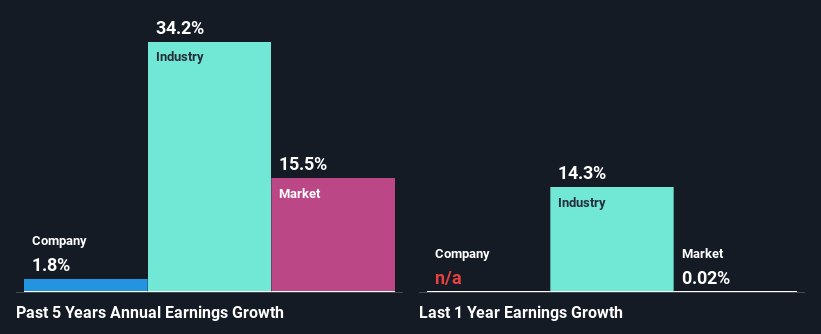Are High Peak Royalties Limited's (ASX:HPR) Mixed Financials The Reason For Its Gloomy Performance on The Stock Market?
It is hard to get excited after looking at High Peak Royalties' (ASX:HPR) recent performance, when its stock has declined 7.1% over the past month. It seems that the market might have completely ignored the positive aspects of the company's fundamentals and decided to weigh-in more on the negative aspects. Fundamentals usually dictate market outcomes so it makes sense to study the company's financials. In this article, we decided to focus on High Peak Royalties' ROE.
Return on equity or ROE is a key measure used to assess how efficiently a company's management is utilizing the company's capital. In simpler terms, it measures the profitability of a company in relation to shareholder's equity.
View our latest analysis for High Peak Royalties
How To Calculate Return On Equity?
Return on equity can be calculated by using the formula:
Return on Equity = Net Profit (from continuing operations) ÷ Shareholders' Equity
So, based on the above formula, the ROE for High Peak Royalties is:
5.2% = AU$493k ÷ AU$9.5m (Based on the trailing twelve months to June 2023).
The 'return' is the yearly profit. That means that for every A$1 worth of shareholders' equity, the company generated A$0.05 in profit.
What Is The Relationship Between ROE And Earnings Growth?
So far, we've learned that ROE is a measure of a company's profitability. We now need to evaluate how much profit the company reinvests or "retains" for future growth which then gives us an idea about the growth potential of the company. Generally speaking, other things being equal, firms with a high return on equity and profit retention, have a higher growth rate than firms that don’t share these attributes.
High Peak Royalties' Earnings Growth And 5.2% ROE
On the face of it, High Peak Royalties' ROE is not much to talk about. We then compared the company's ROE to the broader industry and were disappointed to see that the ROE is lower than the industry average of 22%. As a result, High Peak Royalties' flat net income growth over the past five years doesn't come as a surprise given its lower ROE.
Next, on comparing with the industry net income growth, we found that High Peak Royalties' reported growth was lower than the industry growth of 34% over the last few years, which is not something we like to see.
Earnings growth is a huge factor in stock valuation. The investor should try to establish if the expected growth or decline in earnings, whichever the case may be, is priced in. Doing so will help them establish if the stock's future looks promising or ominous. Is High Peak Royalties fairly valued compared to other companies? These 3 valuation measures might help you decide.
Is High Peak Royalties Making Efficient Use Of Its Profits?
High Peak Royalties doesn't pay any dividend, meaning that potentially all of its profits are being reinvested in the business. However, this doesn't explain why the company hasn't seen any growth. It looks like there might be some other reasons to explain the lack in that respect. For example, the business could be in decline.
Summary
In total, we're a bit ambivalent about High Peak Royalties' performance. Even though it appears to be retaining most of its profits, given the low ROE, investors may not be benefitting from all that reinvestment after all. The low earnings growth suggests our theory correct. Until now, we have only just grazed the surface of the company's past performance by looking at the company's fundamentals. To gain further insights into High Peak Royalties' past profit growth, check out this visualization of past earnings, revenue and cash flows.
Have feedback on this article? Concerned about the content? Get in touch with us directly. Alternatively, email editorial-team (at) simplywallst.com.
This article by Simply Wall St is general in nature. We provide commentary based on historical data and analyst forecasts only using an unbiased methodology and our articles are not intended to be financial advice. It does not constitute a recommendation to buy or sell any stock, and does not take account of your objectives, or your financial situation. We aim to bring you long-term focused analysis driven by fundamental data. Note that our analysis may not factor in the latest price-sensitive company announcements or qualitative material. Simply Wall St has no position in any stocks mentioned.
